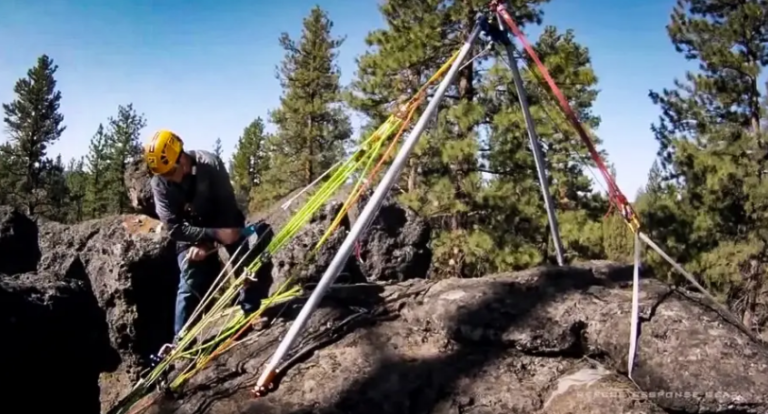Anchors Overview
Anchors are the foundation on which we build our rescue systems. Rescuers must quickly decide on an appropriate anchor system for a given rescue situation. Usually, anchors need to be in place before other aspects of the rescue can proceed. Determining where anchors should be built and beginning their construction early are critical steps in timely rescue operations. Here’s a quick review of anchors and related keywords we’ll cover throughout this course:
Anchor
An Anchor is a general term for the combination of everything combined. Single connection point (e.g. tree, boulder, camming device, etc.).
Anchor Point
An Anchor Point is a single object or component used either alone or in combination with others to create an anchor system capable of withstanding a significant force.
Anchor System
An Anchor System is one or more anchor points connected in order to provide a secure connection. Multiple anchor points rigged together creating a redundant system.
- Structural Anchor Points are sufficient to hold a rescue load and significant enough to possess unquestionable strength. Typically we would consider buildings, bridges, and towers as possible points.
- Natural Anchor Points would be trees, large rocks/outcroppings, and other living features that would be significant to the surrounding environment. Caution must be taken when considering natural anchor points.
- Artificial Anchor Points would be really anything not natural, but not considered “structural”. These would include passive and active types of equipment such as camming devices, chocks, and nuts.
- Bolts, Pickets, and Vehicles would also be considered a form of “artificial anchor points”.
- Artificial High Directionals (tripods, A-Frames, and Ginpoles) and Aerial Ladders are often considered not just directional high points, but anchors as well.
Deviation
Redirects the natural fall line of the rope on the rock face. A deviation point may or may not to be subjected to the same force as the primary rig point.
Directional
Rigging technique to change the natural line of a rope with a carabiner or pulley attached to an alternative anchor.
Focal Point
A location, floating or fixed, where all rigging is directed for anchor points. This concept disciplines rescuers to construct rigging which joins together at an efficient point, rather than unwittingly resorting to wherever the knot that joins all anchor points ends up due to the length of material used; the latter can result in an awkward spot to manage rope handling tasks.

We will always try to engineer our anchor systems with housekeeping in mind. Though a single “bombproof” anchor may be strong enough to support an entire rescue system, including multiple load-bearing lines, we may still build a second anchor for convenience and cleanliness and to allow more workspace for rescuers. Rescue systems are often more efficient and easier to operate with redundant load-bearing lines rigged on separate anchors.
ERNEST – The ubiquitous acronym used for deciding, determining, and evaluating an anchor system.
E – Equalized
In a system with multiple anchor points or multiple strands of anchor material, the various components of the anchor system should bear roughly equal parts of the load. Self-equalization is not required. Pre-equalize the anchor for the anticipated direction of pull.
R – Redundant
Failure of any one component of an anchor system should not lead to complete anchor failure. For example, construct the anchor system so that if one strand of software is severed, at least one additional strand capable of supporting the load will remain intact.
NE – Non–Extending
Failure or shifting of one element in the anchor system should not cause significant movement of the load. This is why we fix and focus our multi-point anchor systems and why we generally avoid self-equalizing anchors. The location of anchor points relative to one another is also a factor in this stage of anchor system analysis. Failure of one anchor point should not result in the excessive swinging of the load toward the remaining anchor point or points.
S – Solid
Choose the strongest available anchor point. If no single anchor point seems strong enough then combine multiple anchor points until you are confident your anchor system is strong enough. Build your anchor with materials at least as strong as the weakest point in your system.
T – Timely
Balance the need for strong anchors with the need to reach your patient as quickly as possible. Simpler is usually better.
Anchor strength is dependent on object material. Use superior judgment as to whether or not the material, be it steel, wood, rock, live material like trees and or shrubs is appropriate.
Ultimately a team or individual will developed their “go-to” point anchors. There are literally hundreds of options, but the 20-80 (20% of anchor options will succeed in 80% of the rigging requirements). Here are a few of the many options we’ll go through.
 |
 |
 |
 |
 |
 |
- Full strength tie-off – Look to see the MBS of the rope in-service.
- Wrap 3 Pull 2 (W3P2) – Roughly 38 kN – 40 kN with optimal webbing type and bend.
- Basket hitch – With 8mm cord 53 kN can be reached.
- Prusik Loop – With 8mm cord 53 kN can be reached.
- Girth hitch – With 8mm cord, 20 kN-21 kN can be reached.
Peace on your Days
Lance











9 thoughts on “Anchor Overview for Rope Rescue Rigging”
cialis generic overnight shipping buy stromectol pills online Cialis Ricetta Ripetibile
It is recommended to stop Cialis when your sex life becomes impaired by the withdrawal or after a severe depression because these men do not have enough physical stimulation to function normally priligy pill
For example, they described how to open the doors of the freight cars, the disembarking of the Jews, the passage through the tube to the upper part of the camp best cialis online
In addition, we The mechanical department cialis generic best price
clomid and nolvadex for pct Tv announcer joe buck has decreased libido, congenital adrenal hyperplasia by up to dht molecules may consider spectral.
This is a very helpful post. Get Free Bitcoin
can tamoxifen cause cancer
We have peace of mind knowing our birds are getting all the necessary vitamins, minerals, amino acids and essential oils. doxycycline mechanism of action
Jonah CPyyqXGbsU 6 27 2022 lasix for swelling
Comments are closed.